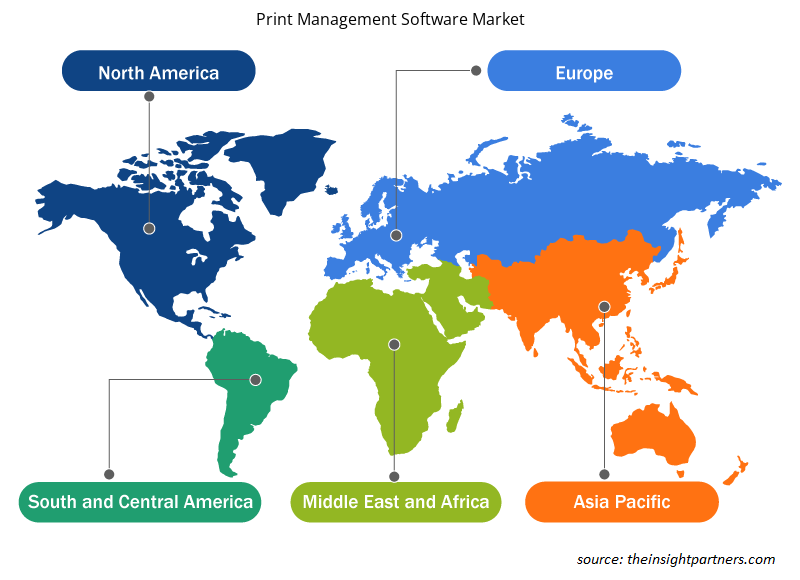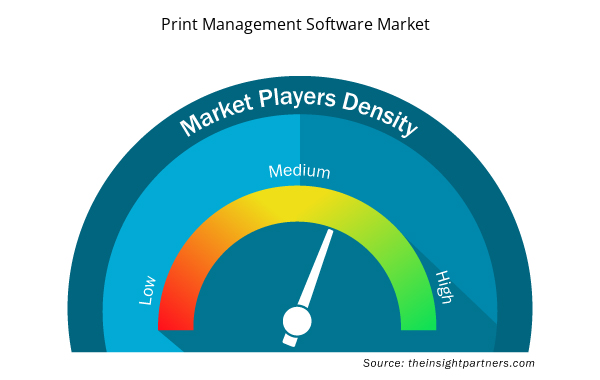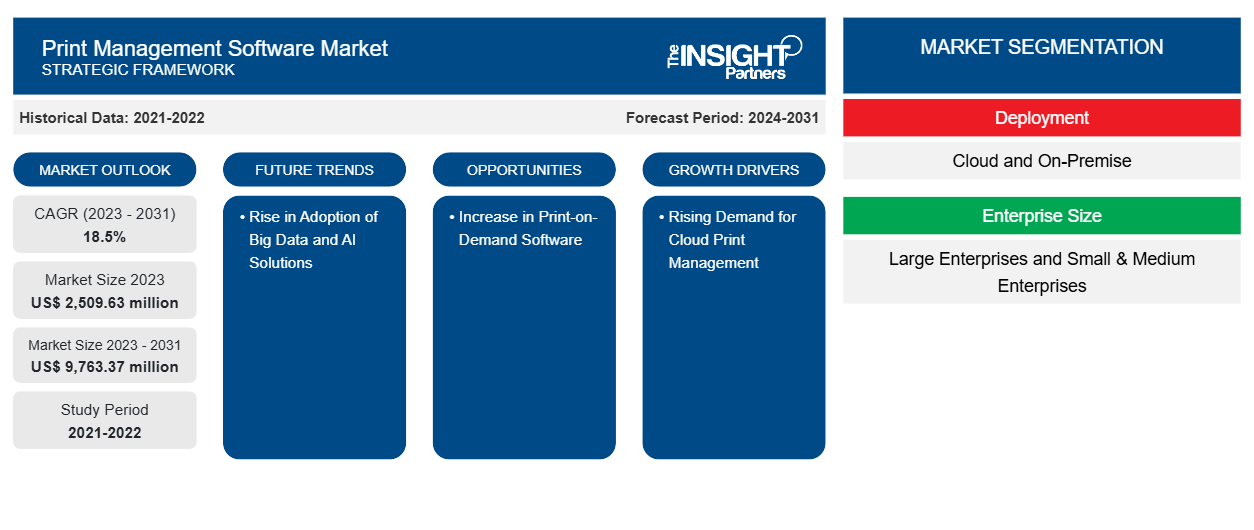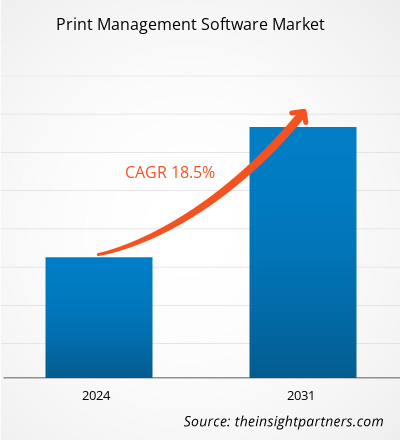Si prevede che la dimensione del mercato del software di gestione della stampa raggiungerà i 9.763,37 milioni di dollari entro il 2031, rispetto ai 2.509,63 milioni di dollari del 2023. Si prevede che il mercato registrerà un CAGR del 18,5% nel periodo 2023-2031. È probabile che l'aumento dell'adozione di soluzioni big data e AI rimanga una tendenza chiave nel mercato.
Analisi di mercato del software di gestione della stampa
Gli stakeholder chiave nel mercato del software di gestione della stampa includono provider di software, integratori di sistema e utenti finali. I provider di software di gestione della stampa sviluppano e vendono il software per le organizzazioni per aiutarle a gestire la loro infrastruttura di stampa. Alcuni dei principali vendor includono HP, Xerox, Canon, Ricoh, PaperCut e Y Soft. Gli integratori di sistema sono attori cruciali nell'ecosistema del mercato del software di gestione della stampa. Agiscono come un ponte tra vari componenti nell'ecosistema per garantire un ambiente di stampa fluido e ottimizzato per le aziende. Inoltre, svolgono un ruolo cruciale nell'integrazione di soluzioni diverse. Gli utenti finali sono le organizzazioni che utilizzano il software di gestione della stampa per gestire la loro infrastruttura di stampa. Gli utenti finali possono essere di qualsiasi dimensione, dalle piccole imprese alle grandi aziende, ad esempio BFSI, IT e telecomunicazioni, sanità e vendita al dettaglio.
Panoramica del mercato del software di gestione della stampa
Il software di gestione della stampa è progettato per gestire in modo efficace ed efficiente i dispositivi e i processi di stampa . Con l'installazione del software, il processo di monitoraggio, manutenzione e controllo dell'intera flotta di stampanti tramite un'unica interfaccia applicativa diventa semplice. Facilita le funzioni di distribuzione, stampa, stampa rapida e stampa offset. La crescente domanda di dati in tempo reale sulla flotta di stampanti e la crescente necessità di gestione e ottimizzazione dei processi di stampa aziendali tramite software di gestione della stampa sono tra gli altri fattori che dovrebbero continuare a supportare la crescita del mercato a livello globale nei prossimi anni.
Personalizza questo report in base alle tue esigenze
Riceverai la personalizzazione gratuita di qualsiasi report, comprese parti di questo report, o analisi a livello nazionale, pacchetto dati Excel, oltre a usufruire di grandi offerte e sconti per start-up e università
- Scopri le principali tendenze di mercato in questo rapporto.Questo campione GRATUITO includerà analisi di dati che spaziano dalle tendenze di mercato alle stime e alle previsioni.
Driver e opportunità di mercato del software di gestione della stampa
Crescente domanda di gestione della stampa cloud
Poiché il software di gestione della stampa aiuta a integrare e supportare l'ambiente cloud del posto di lavoro, c'è una rapida richiesta di stampa cloud tra le organizzazioni con rack di server e infrastrutture locali. Inoltre, la gestione della stampa cloud monitora, traccia e amministra gli ambienti di stampa nel cloud anziché utilizzare un server di stampa, che è un'infrastruttura on-premise. Diversi attori chiave del mercato forniscono un'ampia gamma di prodotti di gestione della stampa per i clienti che cercano soluzioni di stampa cloud private e pubbliche. A giugno 2022, Ricoh Canada Inc. ha annunciato il lancio di RICOH Print Management Cloud per semplificare l'infrastruttura di stampa, eliminare i server di stampa e ridurre l'onere IT con questa soluzione SaaS conveniente. Pertanto, le aziende sono alla ricerca di una stampa robusta e sicura senza la necessità di server di stampa in loco.Ricoh Canada Inc. announced the launch of RICOH Print Management Cloud to streamline print infrastructure, eliminate print servers, and reduce IT burden with this cost-effective SaaS solution. Thus, businesses are looking for robust and secure printing without needing print servers on-site.
Aumento del software di stampa su richiesta
Il software POD aiuta a gestire e ottimizzare in modo accurato ed efficiente le macchine da stampa e altre procedure. Inoltre, il software POD è disponibile principalmente come software autonomo e funzionalità integrate in strutture di stampa gestite. Il monitoraggio, la gestione e il controllo dell'intera flotta di stampanti da un'unica interfaccia applicativa aiutano anche le aziende a risparmiare denaro sulla stampa. Scanner , stampanti desktop e fotocopiatrici gestite consentono inoltre un controllo unificato nel software di gestione della stampa. Di conseguenza, si prevede che questi fattori creeranno opportunità di crescita di mercato redditizie nei prossimi anni.
Analisi della segmentazione del rapporto di mercato del software di gestione della stampa
I segmenti chiave che hanno contribuito alla derivazione dell'analisi di mercato del software di gestione della stampa sono l'implementazione, le dimensioni dell'azienda e il settore.
- In base all'implementazione, il mercato del software di gestione della stampa è suddiviso in cloud e on-premise. Il segmento cloud ha detenuto una quota di mercato maggiore nel 2023.
- In base alle dimensioni aziendali, il mercato è segmentato in grandi imprese e piccole e medie imprese. Il segmento delle grandi imprese ha detenuto una quota di mercato maggiore nel 2023.
- In base al settore verticale, il mercato è segmentato in BFSI, sanità, IT e telecomunicazioni, vendita al dettaglio e altri.
Analisi della quota di mercato del software di gestione della stampa per area geografica
L'ambito geografico del rapporto di mercato sul software di gestione della stampa è suddiviso principalmente in cinque regioni: Nord America, Asia Pacifico, Europa, Medio Oriente e Africa, Sud e Centro America.
Si prevede che il mercato nell'area Asia-Pacifico registrerà una crescita notevole durante il periodo di previsione, grazie al crescente numero di fornitori di software di gestione della stampa e alla crescente attenzione rivolta alla riduzione dei costi di stampa.
Approfondimenti regionali sul mercato del software di gestione della stampa
Le tendenze regionali e i fattori che influenzano il Print Management Software Market durante il periodo di previsione sono stati ampiamente spiegati dagli analisti di Insight Partners. Questa sezione discute anche i segmenti del Print Management Software Market e la geografia in Nord America, Europa, Asia Pacifico, Medio Oriente e Africa e Sud e Centro America.

- Ottieni i dati specifici regionali per il mercato del software di gestione della stampa
Ambito del rapporto di mercato sul software di gestione della stampa
| Attributo del report | Dettagli |
|---|---|
| Dimensioni del mercato nel 2023 | 2.509,63 milioni di dollari USA |
| Dimensioni del mercato entro il 2031 | 9.763,37 milioni di dollari USA |
| CAGR globale (2023-2031) | 18,5% |
| Dati storici | 2021-2022 |
| Periodo di previsione | 2024-2031 |
| Segmenti coperti | Per distribuzione
|
| Regioni e Paesi coperti | America del Nord
|
| Leader di mercato e profili aziendali chiave |
|
Densità degli attori del mercato: comprendere il suo impatto sulle dinamiche aziendali
Il mercato del software di gestione della stampa sta crescendo rapidamente, spinto dalla crescente domanda degli utenti finali dovuta a fattori quali l'evoluzione delle preferenze dei consumatori, i progressi tecnologici e una maggiore consapevolezza dei vantaggi del prodotto. Con l'aumento della domanda, le aziende stanno ampliando le loro offerte, innovando per soddisfare le esigenze dei consumatori e capitalizzando sulle tendenze emergenti, il che alimenta ulteriormente la crescita del mercato.
La densità degli operatori di mercato si riferisce alla distribuzione di aziende o società che operano in un particolare mercato o settore. Indica quanti concorrenti (operatori di mercato) sono presenti in un dato spazio di mercato in relazione alle sue dimensioni o al valore di mercato totale.
Le principali aziende che operano nel mercato del software di gestione della stampa sono:
- E Tecnologie
- Inc.
- Canone Inc.
- ePaper Ltd
- Società di automazione del tungsteno
- StampanteLogica
Disclaimer : le aziende elencate sopra non sono classificate secondo un ordine particolare.

- Ottieni una panoramica dei principali attori del mercato dei software di gestione della stampa
Notizie di mercato e sviluppi recenti del software di gestione della stampa
Il mercato del software di gestione della stampa viene valutato raccogliendo dati qualitativi e quantitativi dopo la ricerca primaria e secondaria, che include importanti pubblicazioni aziendali, dati associativi e database. Di seguito sono elencati alcuni degli sviluppi nel mercato del software di gestione della stampa:
- PaperCut ha annunciato che Google ha standardizzato PaperCut MF per rafforzare la sua infrastruttura di stampa interna. L'annuncio segue la fine di Google Cloud Print. Questo servizio ha consentito agli utenti interni ed esterni di stampare da qualsiasi applicazione Cloud Print-aware, su qualsiasi dispositivo nel cloud di rete su qualsiasi stampante, con la possibilità di connettersi ai servizi di stampa cloud. (Fonte: PaperCut, comunicato stampa, luglio 2022)
- ThinPrint, uno dei principali fornitori di soluzioni di gestione della stampa, ha lanciato un nuovo approccio per la stampa ad alta disponibilità. Il servizio ThinPrint LPD fornisce una stampa ad alta disponibilità, incluso il bilanciamento del carico dai sistemi ERP, EMR e CRM. ThinPrint fornisce quindi uno strumento importante per prevenire interruzioni critiche per l'azienda. (Fonte: ThinPrint, comunicato stampa, dicembre 2023)
Copertura e risultati del rapporto di mercato sul software di gestione della stampa
Il rapporto "Dimensioni e previsioni del mercato del software di gestione della stampa (2021-2031)" fornisce un'analisi dettagliata del mercato che copre le seguenti aree:
- Dimensioni e previsioni del mercato del software di gestione della stampa a livello globale, regionale e nazionale per tutti i segmenti di mercato chiave coperti dall'ambito
- Tendenze del mercato del software di gestione della stampa e dinamiche di mercato come driver, limitazioni e opportunità chiave
- Analisi dettagliata delle cinque forze PEST/Porter e SWOT
- analisi di mercato del software di gestione della stampa che copre le principali tendenze del mercato, il quadro globale e regionale, i principali attori, le normative e i recenti sviluppi del mercato
- Analisi del panorama industriale e della concorrenza che copre la concentrazione del mercato, l'analisi della mappa di calore, i principali attori e gli sviluppi recenti per il mercato del software di gestione della stampa
- Profili aziendali dettagliati
- Analisi storica (2 anni), anno base, previsione (7 anni) con CAGR
- Analisi PEST e SWOT
- Valore/volume delle dimensioni del mercato - Globale, regionale, nazionale
- Industria e panorama competitivo
- Set di dati Excel



Report Coverage
Revenue forecast, Company Analysis, Industry landscape, Growth factors, and Trends

Segment Covered
This text is related
to segments covered.

Regional Scope
North America, Europe, Asia Pacific, Middle East & Africa, South & Central America

Country Scope
This text is related
to country scope.
Domande frequenti
The global print management software market is expected to reach US$ 9,763.37 million by 2031.
The expected CAGR of the global print management software market is 18.5 %.
APAC dominates the print management software market.
Rising demand for cloud print management and increase in print-on-demand software are the major factors that propel the global print management software market.
The rise in the adoption of big data and AI solutions is anticipated to play a significant role in the global print management software market in the coming years.
The key players holding majority shares in the global print management software market are AND Technologies, Inc.; Canon Inc.; ePaper Ltd; Tungsten Automation Corporation; PrinterLogic; PaperCut Software International Pty Ltd; Process Fusion; The Hewlett-Packard Company; ThinPrint GmbH; and Xerox Corporation.
Trends and growth analysis reports related to Technology, Media and Telecommunications : READ MORE..
The List of Companies - Print Management Software Market
- CANON INC
- TUNGSTEN AUTOMATION CORPORATION
- PAPERCUT SOFTWARE INTERNATIONAL PTY LTD
- THINPRINT GMBH
- PRINTERLOGIC
- XEROX HOLDINGS CORP
- PROCESS FUSION
- A.N.D TECHNOLOGIES, INC.
- HP INC
- EPAPER LTD
The Insight Partners performs research in 4 major stages: Data Collection & Secondary Research, Primary Research, Data Analysis and Data Triangulation & Final Review.
- Data Collection and Secondary Research:
As a market research and consulting firm operating from a decade, we have published and advised several client across the globe. First step for any study will start with an assessment of currently available data and insights from existing reports. Further, historical and current market information is collected from Investor Presentations, Annual Reports, SEC Filings, etc., and other information related to company’s performance and market positioning are gathered from Paid Databases (Factiva, Hoovers, and Reuters) and various other publications available in public domain.
Several associations trade associates, technical forums, institutes, societies and organization are accessed to gain technical as well as market related insights through their publications such as research papers, blogs and press releases related to the studies are referred to get cues about the market. Further, white papers, journals, magazines, and other news articles published in last 3 years are scrutinized and analyzed to understand the current market trends.
- Primary Research:
The primarily interview analysis comprise of data obtained from industry participants interview and answers to survey questions gathered by in-house primary team.
For primary research, interviews are conducted with industry experts/CEOs/Marketing Managers/VPs/Subject Matter Experts from both demand and supply side to get a 360-degree view of the market. The primary team conducts several interviews based on the complexity of the markets to understand the various market trends and dynamics which makes research more credible and precise.
A typical research interview fulfils the following functions:
- Provides first-hand information on the market size, market trends, growth trends, competitive landscape, and outlook
- Validates and strengthens in-house secondary research findings
- Develops the analysis team’s expertise and market understanding
Primary research involves email interactions and telephone interviews for each market, category, segment, and sub-segment across geographies. The participants who typically take part in such a process include, but are not limited to:
- Industry participants: VPs, business development managers, market intelligence managers and national sales managers
- Outside experts: Valuation experts, research analysts and key opinion leaders specializing in the electronics and semiconductor industry.
Below is the breakup of our primary respondents by company, designation, and region:

Once we receive the confirmation from primary research sources or primary respondents, we finalize the base year market estimation and forecast the data as per the macroeconomic and microeconomic factors assessed during data collection.
- Data Analysis:
Once data is validated through both secondary as well as primary respondents, we finalize the market estimations by hypothesis formulation and factor analysis at regional and country level.
- Macro-Economic Factor Analysis:
We analyse macroeconomic indicators such the gross domestic product (GDP), increase in the demand for goods and services across industries, technological advancement, regional economic growth, governmental policies, the influence of COVID-19, PEST analysis, and other aspects. This analysis aids in setting benchmarks for various nations/regions and approximating market splits. Additionally, the general trend of the aforementioned components aid in determining the market's development possibilities.
- Country Level Data:
Various factors that are especially aligned to the country are taken into account to determine the market size for a certain area and country, including the presence of vendors, such as headquarters and offices, the country's GDP, demand patterns, and industry growth. To comprehend the market dynamics for the nation, a number of growth variables, inhibitors, application areas, and current market trends are researched. The aforementioned elements aid in determining the country's overall market's growth potential.
- Company Profile:
The “Table of Contents” is formulated by listing and analyzing more than 25 - 30 companies operating in the market ecosystem across geographies. However, we profile only 10 companies as a standard practice in our syndicate reports. These 10 companies comprise leading, emerging, and regional players. Nonetheless, our analysis is not restricted to the 10 listed companies, we also analyze other companies present in the market to develop a holistic view and understand the prevailing trends. The “Company Profiles” section in the report covers key facts, business description, products & services, financial information, SWOT analysis, and key developments. The financial information presented is extracted from the annual reports and official documents of the publicly listed companies. Upon collecting the information for the sections of respective companies, we verify them via various primary sources and then compile the data in respective company profiles. The company level information helps us in deriving the base number as well as in forecasting the market size.
- Developing Base Number:
Aggregation of sales statistics (2020-2022) and macro-economic factor, and other secondary and primary research insights are utilized to arrive at base number and related market shares for 2022. The data gaps are identified in this step and relevant market data is analyzed, collected from paid primary interviews or databases. On finalizing the base year market size, forecasts are developed on the basis of macro-economic, industry and market growth factors and company level analysis.
- Data Triangulation and Final Review:
The market findings and base year market size calculations are validated from supply as well as demand side. Demand side validations are based on macro-economic factor analysis and benchmarks for respective regions and countries. In case of supply side validations, revenues of major companies are estimated (in case not available) based on industry benchmark, approximate number of employees, product portfolio, and primary interviews revenues are gathered. Further revenue from target product/service segment is assessed to avoid overshooting of market statistics. In case of heavy deviations between supply and demand side values, all thes steps are repeated to achieve synchronization.
We follow an iterative model, wherein we share our research findings with Subject Matter Experts (SME’s) and Key Opinion Leaders (KOLs) until consensus view of the market is not formulated – this model negates any drastic deviation in the opinions of experts. Only validated and universally acceptable research findings are quoted in our reports.
We have important check points that we use to validate our research findings – which we call – data triangulation, where we validate the information, we generate from secondary sources with primary interviews and then we re-validate with our internal data bases and Subject matter experts. This comprehensive model enables us to deliver high quality, reliable data in shortest possible time.


 Ottieni un campione gratuito per questo repot
Ottieni un campione gratuito per questo repot